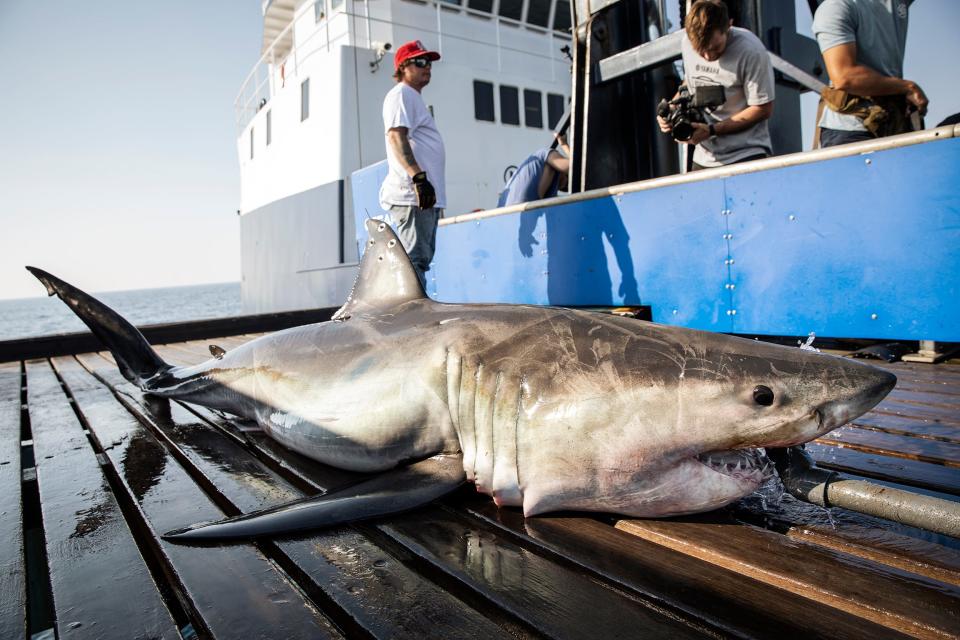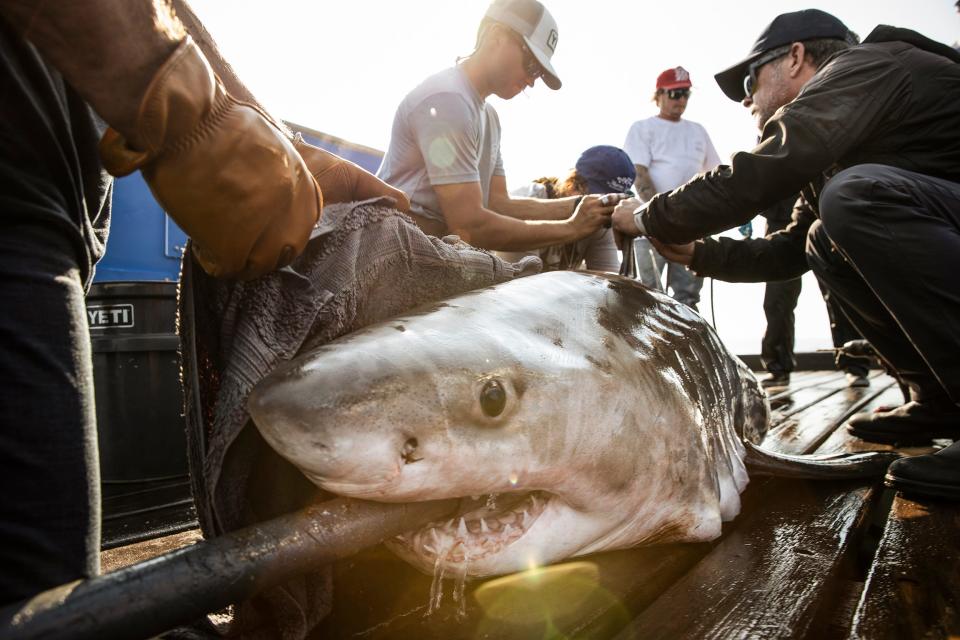White shark located near Rye's Jenness Beach: What to know and how shark tracking works
RYE — A nine-foot-plus white shark tagged by researchers this spring appeared roughly one nautical mile off Jenness Beach this week, an ocean data organization has reported.
The 425-pound juvenile fish, tagged and tracked by OCEARCH, a nonprofit marine life research group, last pinged its location to researchers early Monday, June 26 in the waters near the Rye shore.
The shark is named Anne Bonny in honor of the early 1700s Irish pirate.

A virtual shark tracker map operated by OCEARCH shows Anne Bonny, tagged by researchers off Ocracoke, North Carolina on April 21, has traveled as far north as the Canadian Grand Manan Island, but has since looped back down toward New England.
En route toward Canada before heading back south, Anne Bonny passed through Rhode Island Sound and through Cape Cod. Anne Bonny is the organization’s 90th shark to be tagged in the northwestern Atlantic Ocean, according to OCEARCH.
More: Here's list of July 4 fireworks, events in Seacoast NH and southern Maine for 2023
Since 2007, when it launched its first expedition to Guadalupe Island, OCEARCH has tagged 437 animals over 45 trips around the world.
Expert advice from Seacoast Science Center team
The Seacoast Science Center’s Marine Mammal Rescue team advised beachgoers should adhere to all signs and flag warnings at the beach, avoid being alone in the ocean and stay out of areas where seals and schools of fish are located.
“If you see something in the water that you’re unsure about, play it safe and get out,” the team advises.
Between May and October, white sharks can frequent New Hampshire waters while going undetected, according to the Seacoast Science Center.
What to know about white sharks and local waters
The National Marine Fisheries Service states white sharks can live upwards of 70 years, grow to as heavy as 4,500 pounds and reach 21 feet long.
The white shark species can be found worldwide in temperate and subtropical waters, including on the Atlantic coast from Maine to the Gulf of Mexico and the U.S. Caribbean. Off the Pacific Ocean, white sharks can be found off Alaska, California and Hawaii.
“Rumors about the presence of sharks near the beach can spread like wildfire, and so can misinformation about our ocean’s great predators,” said Brian Yurasits, the Marine Mammal Rescue team’s community outreach manager. “It is normal for sharks to inhabit the Gulf of Maine.”

The sharks, according to the National Marine Fisheries Service, migrate seasonally in order to find their preferred water temperature range of between anywhere 50 to 80 degrees.
“But despite its fearsome reputation, its large size and low productivity (reproductive rates, growth rates, age at maturity, longevity, etc.) make the white shark vulnerable to declines from human impacts,” the National Marine Fisheries Service states. “Due to these natural vulnerabilities, the white shark is one of the most widely protected sharks globally.”
Shark tracking in Seacoast NH
News of the shark’s location comes a year after the Rye Fire Department, partnering with the Marine Mammal Rescue team, Atlantic White Shark Conservancy, the New Hampshire Port Authority and Seacoast Maritime Charters, purchased shark-tracking buoys for the town’s beaches. The initiative was spearheaded in response to the first recorded fatal shark attack in Maine, which occurred when a 63-year-old New York City woman died after being bitten by a great white shark while swimming off Bailey Island.
More: Fatal Maine shark attack spurs great white tracking efforts at these Seacoast beaches
Last year, the town deployed four buoys located off Pirates Cove, Foss, Cable and Sawyers beaches at depths of about 25 feet at high tide. The buoys, recently placed in the ocean again for the summer, contain sensors to detect any tagged great white shark that comes within 1,500 feet.
The buoys recorded one tagged shark last year, a 12-foot white shark named Rocinante that traveled past Foss Beach in Rye.
Data from the Atlantic White Shark Conservancy states the previous most recent shark sighting in New Hampshire waters came on June 4, according to the Seacoast Science Center.
In the last nine years, the Marine Mammal Rescue team, which tends to sick, injured or deceased marine mammals from Essex, Massachusetts up to the Seacoast region, has responded to 17 suspected or confirmed incidents of shark predation on seals.
The Marine Mammal Rescue team reported that as of now, Anne Bonny likely eats fish, small sharks and rays. As adults, white sharks feast on seals, dolphins, sea turtles and whale blubber.
This article originally appeared on Portsmouth Herald: White shark 'Anne Bonny' located near Jenness Beach in Rye NH

